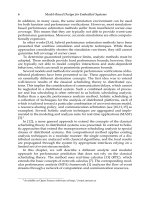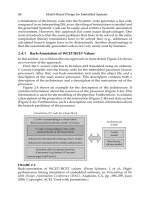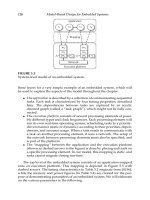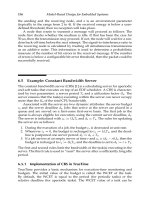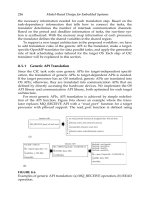Model-Based Design for Embedded Systems- P58 pot
Bạn đang xem bản rút gọn của tài liệu. Xem và tải ngay bản đầy đủ của tài liệu tại đây (414.56 KB, 10 trang )
Nicolescu/Model-Based Design for Embedded Systems 67842_C016 Finals Page 556 2009-10-2
556 Model-Based Design for Embedded Systems
18. A. Jantsch, Modeling Embedded Systems and SoCs—Concurrency and Time in
Models of Computation. Systems on Silicon. Morgan Kaufmann Publishers,
San Francisco, CA, June 2003.
19. T. G. Kim, DEVSim++ User’s Manual, SMSLab, Dept. of EECS, KAIST,
Taejon, Korea, 1994,
20. Y. J. Kim, J. H. Kim, and T. G. Kim, Heterogeneous simulation framework
using DEVS-BUS, in Simulation, the Society for Modeling and Simulation
International, 79, 2003, 3–18.
21. E. A. Lee and H. Zheng, Operational semantics of hybrid systems,
in Hybrid Systems: Computation and Control: 8th International Workshop,
HSCC, Zurich, Switzerland, 2005, pp. 25–53.
22. E. A. Lee and A. L. Sangiovanni-Vincentelli, Comparing models of com-
putation, in IEEE Proceedings of the International Conference on Computer-
Aided Design (ICCAD), San Jose, CA, 1996, pp. 234–241.
23. S. Levitan, J. Martinez, T. Kurzveg, P. Marchand, and D. Chiarulli, Multi
technology system-level simulation, Analog Integrated Circuits and Signal
Processing, 29, 2001, 127–149.
24. MATLAB-Simulink [Online]. Available at: www.mathworks.com
25. J F. Monin, Understanding Formal Methods, Springer, Berlin, 2003.
26. G. Nicolescu et al., Validation in a component-based design flow for mul-
ticore SoCs, in Proceedings of ISSS, Kyoto, Japan, 2002, pp. 162–167.
27. D. H. Patel and S. K. Shukla, SystemC Kernel—Extensions for Heterogeneous
System Modeling, Kluwer Academic Publishers, Dordrecht, the Nether-
lands, 2004.
28. Ptolemy project [Online]. Available at: keley.
edu/
29. S. Romitti, C. Santoni, and P. François, A design methodology and a pro-
totyping tool dedicated to adaptive interface generation, in Proceedings
of the 3rd ERCIM Workshop on “User Interfaces for All”, Obernai, France,
1997.
30. SystemC LRM [Online]. Available at: www.systemc.org
31. SystemVerilog [Online]. Available at: www.systemverilog.org
32. A. Vachoux, C. Grimm, and K. Einwich, Analog and mixed signal model-
ing with SystemC-AMS, in Proceedings International on Symposium Circuits
System, Bangkok, Thailand, 2003, pp. 914–917.
Nicolescu/Model-Based Design for Embedded Systems 67842_C016 Finals Page 557 2009-10-2
Generic Methodology for the Design 557
33. VHDL [Online]. Available at: www.vhdl.org
34. B. P. Zeigler, H. Praehofer, and T. G. Kim, Modeling and Simulation—
Integrating Discrete Event and Continuous Complex Dynamic Systems, Aca-
demic Press, San Diego, CA, 2000.
35. G. Wainer, Modeling and simulation of complex systems with cell-DEVS,
in Winter Simulation Conference, Washington, DC, 2004, pp. 49–60.
36. F. Wang, Formal verification of times systems: A survey and perspective,
Proceedings of the IEEE, 92, 2004, 1283–1305.
Nicolescu/Model-Based Design for Embedded Systems 67842_C016 Finals Page 558 2009-10-2
Nicolescu/Model-Based Design for Embedded Systems 67842_C017 Finals Page 559 2009-10-2
17
Modeling and Simulation of Mixed
Continuous and Discrete Systems
Edward A. Lee and Haiyang Zheng
CONTENTS
17.1 Introduction 559
17.2 Related Work 560
17.3 Actor-Oriented Models 561
17.4 Actor Abstract Semantics 563
17.5 Synchronous/Reactive Models 566
17.6 Discrete-Event Models 568
17.7 Continuous-Time Models 573
17.8 Software Implementation 576
17.9 Conclusions 578
Acknowledgments 578
References 579
17.1 Introduction
An embedded system mixes digital controllers realized in hardware and soft-
ware with the continuous dynamics of physical systems [30]. Such systems
are semantically heterogeneous, combining continuous dynamics, periodic
timed actions, and asynchronous event reactions. Modeling and design of
such heterogeneous systems is challenging. A number of researchers have
defined concurrent models of computation (MoCs) that support modeling,
specification, and design of such systems [11,22,26,28,34].
A variety of approaches have been tried for dealing with the intrin-
sic heterogeneity of embedded systems. This chapter describes a particu-
larly useful combination of semantics, providing a disciplined and rigorous
mixture of synchronous/reactive (SR) systems [4], discrete-event (DE) sys-
tems [13,19,29,49], and continuous-time (CT) dynamics [20,35,42,46]. Our
approach embraces heterogeneity, in that subsystems can be modeled using
any of the three semantics, and these subsystem models can be combined
hierarchically to form a whole system. We leverage the idea of an actor
abstract semantics [33] to provide a coherent and rigorous meaning for
559
Nicolescu/Model-Based Design for Embedded Systems 67842_C017 Finals Page 560 2009-10-2
560 Model-Based Design for Embedded Systems
the heterogeneous system. Our approach also provides improvements to
conventional DE and CT semantics by leveraging the principles of SR lan-
guages. These improvements facilitate the heterogeneous combination of the
three distinct modeling styles.
17.2 Related Work
A number of authors advocate heterogeneous combinations of semantics.
Ptolemy Classic [11] introduced the concept, showing useful combinations
of asynchronous models based on variants of dataflow and timed DE mod-
els. The concept was picked up for hardware design in SystemC (version
2.0 and higher) [45], on which some researchers have specifically built
heterogeneous design frameworks [26]. Metropolis [22] introduced com-
munication refinement as a mechanism for specializing a general MoC in
domain-specific ways, and also introduced quantity managers that provide
a unified approach to resource management in heterogeneous systems.
Our approach in this chapter is closest in spirit to SML-Sys [41], which
builds on Standard ML to provide for mixtures of MoCs. SML-Sys combines
asynchronous models (dataflow models) with synchronous models (which
the authors call “timed”). Our approach, in contrast, combines only timed
models, including both DE and CT dynamics.
A particular form of heterogeneous systems, hybrid systems provide for
joint modeling of continuous and discrete dynamics. A few software tools
have been built to provide simulation of hybrid systems, including Charon
[2], Hysdel [47], HyVisual [10], Modelica
TM
[46], Scicos [16], Shift [15], and
Simulink
R
/Stateflow
TM
(from The MathWorks). An excellent analysis and
comparison of these tools is given by Carloni et al. [12]. We have previ-
ously extensively studied the semantics of hybrid systems as heterogenous
combinations of finite state machines (FSM) and continuous dynamics [35].
Our approach in this chapter extends this to include SR and DE models. We
focushereontheinteractionsbetweenSR,DE,andCT,becausetheinteractions
betweenFSMandSR,DE,andCThavealreadybeenextensivelystudied[21,35].
Several authors advocate unified MoCs as a binding agent for hetero-
geneous models [3,9,23]. Heterogeneous designs are expressed in terms of
a common semantics. Some software systems, such as Simulink from The
MathWorks, take the approach of supporting a general MoC (CT systems
in the case of Simulink) within which more specialized behaviors (like peri-
odic discrete-time) can be simulated. The specialized behaviors amount to
a design style or design pattern within a single unified semantics. Con-
formance to design styles within this unified semantics can result in mod-
els from which effective embedded software can be synthesized, using, for
example, Real-Time Workshop
TM
or TargetLink
TM
from dSpace.
Nicolescu/Model-Based Design for Embedded Systems 67842_C017 Finals Page 561 2009-10-2
Mixed Continuous and Discrete Systems 561
Our approach in this chapter is different in that the binding agent is an
abstract semantics. By itself, it is not sufficiently complete to specify system
designs. Its role is exclusively as a binding agent between diverse concrete
MoCs, each of which is expressive enough to define system behavior (each
in a different way).
We are heavily inspired here by the fixed-point semantics of synchronous
languages [4], particularly Lustre [25], Esterel [8], and Signal [24]. SCADE [7]
(Safety Critical Application Development Environment), a commercial prod-
uct of Esterel Technologies, builds on the synchronous language, Lustre [25],
providing a graphical programming framework with Lustre semantics. All
the synchronous languages have strong formal properties that yield quite
effectively to formal verification techniques. Our approach, however, is to
use the principles of synchronous languages in the style of a coordination
language rather than a programming language. This coordination language
approach has been realized in Ptolemy [17] and ForSyDe [44]. It allows for
“primitives” in a model to be complex components rather than built-in lan-
guage primitives. This approach will allow for heterogeneous combinations
of MoCs, since the complex components may themselves be given as compo-
sitions of further subcomponents under some other MoCs.
A number of researchers have combined synchronous languages with
asynchronous interactions using a principle called globally asynchronous,
locally synchronous or GALS (see for example [5]). In our case, all the
MoCs we consider are timed, so there is a measure of synchrony through-
out. Instead, we focus on combinations of heterogeneous timing properties,
including abstracted discrete sequences (SR), time-stamped events (DE), and
continuous-time dynamics (CT).
17.3 Actor-Oriented Models
Our approach here closely follows the principles of actor-oriented design
[33], a component methodology where components called actors execute and
communicate with other actors in a model, as illustrated in Figure 17.1. Fig-
ure 17.1 shows an actor with a single output port that produces a sequence
of data values that constitute a sine wave. Internally, the actor is realized as a
network of actors. It has three parameters, frequency, phase,andsamplingFre-
quency, with default values shown.
Actors have a well-defined component interface. This interface abstracts
the internal state and behavior of an actor, and restricts how an actor
interacts with its environment. The interface includes ports that represent
points of communication for an actor, and parameters that are used to con-
figure the operation of an actor. Often, parameter values are part of the
aprioriconfiguration of an actor and do not change when a model is
Nicolescu/Model-Based Design for Embedded Systems 67842_C017 Finals Page 562 2009-10-2
562 Model-Based Design for Embedded Systems
SR director
Ramp
Const.
Phase
Composite actor
Sine wave
Hierarchical abstraction
AddSubtract
External port
Sin
Actor
Port
Output
TrigFunction
+
–
Frequency : 440Frequency : 440
Phase : 0.0 Phase : 0.0
Sampling frequency : 8000Sampling frequency : 8000
FIGURE 17.1
Illustration of a composite actor (above) and its hierarchical abstraction
(below).
executed. The configuration of a model also contains explicit communica-
tion channels that pass data from one port to another. The use of channels to
mediate communication implies that actors interact only with the channels
that they are connected to and not directly with other actors.
Like actors, which have a well-defined external interface, a composition
of actors may also define an external interface, which we call its hierarchi-
cal abstraction. This interface consists of external ports and external parameters,
which are distinct from the ports and parameters of the individual actors in
the composite. The external ports of a composite can be connected (on the
inside) by channels to other external ports of the composite or to the ports
of actors within the composite. External parameters of a composite can be
used to determine the values of the parameters of actors inside the compos-
ite. Actors that are not composite actors are called atomic actors. We assume
that the behavior of atomic actors is given in a host language (in Ptolemy II,
Java, or C).
Taken together, the concepts of actors, ports, parameters, and channels
describe the abstract syntax of actor-oriented design. This syntax can be rep-
resented concretely in several ways, such as graphically, as in Figure 17.1,
in XML [32], or in a program designed to a specific API (as in SystemC).
Ptolemy II [18] offers all three alternatives. In some systems, such as SML-
Sys, the syntax of the host language specifies the interconnection of actors.
It is important to realize that the syntactic structure of an actor-oriented
design says little about the semantics. The semantics is largely orthogonal to
the syntax, and is determined by an MoC. The model of computation might
give operational rules for executing a model. These rules determine when
actors perform internal computation, update their internal state, and perform
Nicolescu/Model-Based Design for Embedded Systems 67842_C017 Finals Page 563 2009-10-2
Mixed Continuous and Discrete Systems 563
external communication. The model of computation also defines the nature
of communication between components (buffered, rendezvous, etc.).
Our notion of actor-oriented modeling is related to the term actor as
introduced in the 1970s by Carl Hewitt of MIT to describe the concept of
autonomous reasoning agents [27]. The term evolved through the work
of Agha and others to describe a formalized model of concurrency [1].
Agha’s actors each have an independent thread of control and communi-
cate via asynchronous message passing. We are further developing the term
to embrace a larger family of models of concurrency that are often more con-
strained than general message passing. Our actors are still conceptually con-
current, but unlike Agha’s actors, they need not have their own thread of
control. Moreover, although communication is still through some form of
message passing, it need not be strictly asynchronous.
In this chapter, we will consider three MoCs, namely, SR, DE, and CT.
We carefully define the semantics of DE and CT so that the three MoCs are
related in an interesting way. Specifically, SRis a special case of DE, and DE is
a special case of CT. This does not mean that we should automatically use the
most general MoC, CT, because execution efficiency, modeling convenience,
and synthesizability all may be compromised. In fact, there are good reasons
to use all three MoCs.
Most interestingly, we will show that these three MoCs can be combined
hierarchically in arbitrary order. That is, in a hierarchical model like that in
Figure 17.1, the higher level of the hierarchy and the lower level need not use
the same MoC. In fact, all combinations of SR, DE, and CT are supported by
our framework. We describe a prototype of this framework constructed in
Ptolemy II.
17.4 Actor Abstract Semantics
In order to preserve the specialization of MoC while also building general
models overall, we concentrate on the hierarchical composition of heteroge-
nous MoC. The composition of arbitrary MoC is made tractable by an abstract
semantics, which abstracts how communication and flow of control work. The
abstract semantics is (loosely speaking) not the union of interesting seman-
tics, but rather the intersection. It is abstract in the sense that it represents the
common features of MoC as opposed to their collection of features.
A familiar example of an abstract semantics is represented by the
Simulink S-function interface. Although not formally described as such, it in
fact functions as such. In fact, simulink works with stateflow to accomplish a
limited form of hierarchical heterogeneity through this S-function interface.
We will describe an abstract semantics that is similar to that of Simulink, but
Nicolescu/Model-Based Design for Embedded Systems 67842_C017 Finals Page 564 2009-10-2
564 Model-Based Design for Embedded Systems
simpler. It is the one realized in the Ptolemy II framework for actor-oriented
design.
In Ptolemy II models, a director realizes the model of computation.
A director is placed in a model by the model builder to indicate the model
of computation for the model. For example, an SR director is shown visually
as the uppermost icon in Figure 17.1. The director manages the execution of
the model, defining the flow of control, and also defines the communication
semantics.
When a director is placed in a composite actor, as in Figure 17.1, the com-
posite actor becomes an opaque composite actor. To the outside environ-
ment, it appears to be an atomic actor. But inside, it is a composite, executing
under the semantics defined by the local director. Obviously, there has to be
some coordination between the execution on the outside and the execution
on the inside. That coordination is defined by the abstract semantics.
The flow of control and communication semantics are abstracted in
PtolemyIIbytheexecutable and receiver interfaces, respectively. These inter-
faces define a suite of methods, the semantics of which are the actor abstract
semantics of Ptolemy II. A receiver is supplied for each channel in a model
by the director; this ensures that the communication semantics and flow of
control work in concert to implement the model of computation.
In the Ptolemy II abstract semantics, actors execute in three phases, setup,
a sequence of iterations, and wrapup.Aniteration is a sequence of operations
that read input data, produce output data, and update the state, but in a
particular, structured way. The operations of an iteration consist of one or
more invocations of the following pseudocode:
if (prefire()) {
fire();
}
If fire is invoked at least once in the iteration, then the iteration concludes
with exactly one invocation of postfire.
These operations and their significance constitute the executable inter-
face and are summarized in Figure 17.2. The first part of an itera-
tion is the invocation of prefire, which tests preconditions for firing. The
actor thus determines whether its conditions for firing are satisfied. If it
setup Initialize the actor.
prefire Test preconditions for firing.
fire Read inputs and produce outputs.
postfire Update the state.
wrapup End execution of the actor.
FIGURE 17.2
The key flow of control operations in the Ptolemy II abstract semantics. These
are methods of the executable interface.
Nicolescu/Model-Based Design for Embedded Systems 67842_C017 Finals Page 565 2009-10-2
Mixed Continuous and Discrete Systems 565
indicates that they are (by a return value of true), then the iteration proceeds
by invoking fire. This may be repeated an arbitrary number of times. The con-
tract with the actor is that prefire and fire do not change the state of the actor.
Hence, multiple invocations with the same input values in a given iteration
will produce the same results. This contract is essential to guarantee conver-
gence to a fixed point.
If prefire indicates that preconditions are satisfied, then most actors guar-
antee that invocations of fire and postfire will complete in a finite amount of
time. Such actors are said to realize a precise reaction [37]. A director that tests
these preconditions prior to invoking the actor, and fires the actor only if
the preconditions are satisfied, is said to realize a responsible framework [37].
Responsible frameworks coupled with precise reactions are key to hierarchi-
cal heterogeneity.
The abstract semantics also provides the set of primitive communication
operations as shown in Figure 17.3. These operations allow an actor to query
the state of communication channels, and subsequently retrieve information
from the channels or send information to the channels. These operations are
invoked in prefire and fire. Actors are also permitted to read inputs in postfire,
but they are not permitted to produce outputs (by invoking put). Violations
of this contract can lead to nondeterminism.
These operations are abstract, in the sense that the mechanics of the com-
munication channel is not defined. It is determined by the model of compu-
tation. A domain-polymorphic actor is not concerned with how these oper-
ations are implemented. The actor is designed assuming only the abstract
semantics, not the specific realization.
Ahierarchically heterogeneousmodelis supportedbythis abstractseman-
tics as follows. Figure 17.1 shows an opaque composite actor. It is opaque
because it contains a director. That director gives the composite a behavior
like that of an atomic actor viewed from the outside. A director implements
the executable interface, and thus provides the operations of Figure 17.2.
Suppose that in Figure 17.1 the hierarchical abstraction of the sine wave
component is used in a model of computation different from SR. Then from
the outside, this model will appear to be a domain-polymorphic actor. When
its prefire method is invoked, for example, the inside director must deter-
mine whether the preconditions are satisfied for the model to execute (in the
SR case, they always are), and return true or false accordingly. When fire is
get Retrieveadatatokenviatheport.
put Produce a data token via the port.
hasToken(k) Test whether get will succeed k times.
hasRoom(k) Test whether put will succeed k times.
FIGURE 17.3
Communication operations in Ptolemy II. These are methods of the receiver
interface.

